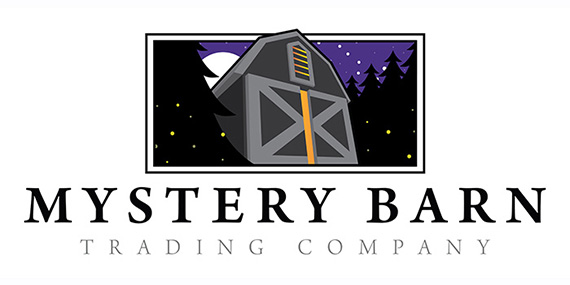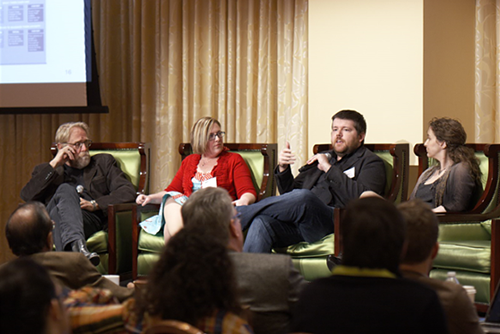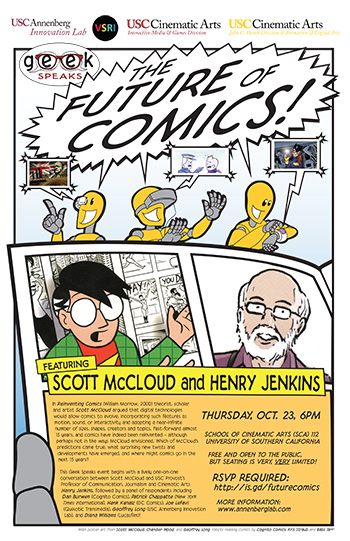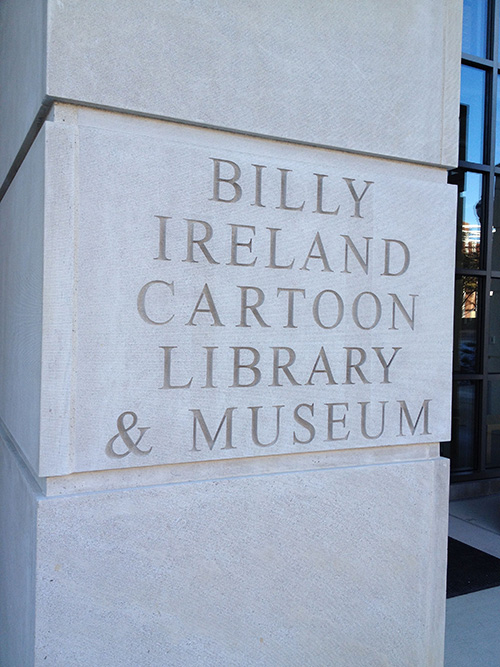|
|
February 27, 2022
9:28 am
Dear blog owner and visitors,
This blog had been infected to serve up Gootloader malware to Google search victims, via a common tactic known as SEO (Search Engine Optimization) poisioning. Your blog was serving up 295 malicious pages. Your blogged served up malware to 0 visitors.
I tried my best to clean up the infection, but I would do the following:
- Upgrade WordPress to the latest version (one way the attackers might have gained access to your server)
- Upgrade all WordPress themes to the latest versions (another way the attackers might have gained access to your server)
- Upgrade all WordPress plugins (another way the attackers might have gained access to your server), and remove any unnecessary plugins.
- Verify all users are valid (in case the attackers left a backup account, to get back in)
- Change all passwords (for WordPress accounts, FTP, SSH, database, etc.) and keys. This is probably how the attackers got in, as they are known to brute force weak passwords
- Run antivirus scans on your server
- Block these IPs (5.8.18.7 and 89.238.176.151), either in your firewall, .htaccess file, or in your /etc/hosts file, as these are the attackers command and control servers, which send malicious commands for your blog to execute
- Check cronjobs (both server and WordPress), aka scheduled tasks. This is a common method that an attacker will use to get back in. If you are not sure, what this is, Google it
- Consider wiping the server completly, as you do not know how deep the infection is. If you decide not to, I recommend installing some security plugins for WordPress, to try and scan for any remaining malicious files. Integrity Checker, WordPress Core Integrity Checker, Sucuri Security,
and Wordfence Security, all do some level of detection, but not 100% guaranteed
- Go through the process for Google to recrawl your site, to remove the malcious links (to see what malicious pages there were, Go to Google and search site:your_site.com agreement)
- Check subdomains, to see if they were infected as well
- Check file permissions
Gootloader (previously Gootkit) malware has been around since 2014, and is used to initally infect a system, and then sell that access off to other attackers, who then usually deploy additional malware, to include ransomware and banking trojans. By cleaning up your blog, it will make a dent in how they infect victims. PLEASE try to keep it up-to-date and secure, so this does not happen again.
Sincerly,
The Internet Janitor
Below are some links to research/further explaination on Gootloader:
https://news.sophos.com/en-us/2021/03/01/gootloader-expands-its-payload-delivery-options/
https://news.sophos.com/en-us/2021/08/12/gootloaders-mothership-controls-malicious-content/
https://www.richinfante.com/2020/04/12/reverse-engineering-dolly-wordpress-malware
https://blog.sucuri.net/2018/12/clever-seo-spam-injection.html
This message

September 27, 2015
11:05 am
Yesterday I took a breather from the nonstop rollercoaster I’ve been on since the semester began. I’ve been planning the Annenberg Innovation Lab’s Think & Do event on The New Creators + Makers, which is going up in Chattanooga, Tennessee on Wednesday and Thursday next week; planning my trip to New York City immediately afterward for the 2015 Future of Storytelling summit; multiple consulting projects for lab partners; and, of course, my coursework for the Ph.D. in Media Arts and Practices that I’ve started over at USC’s School of Cinematic Arts – which includes a big transmedia theory + practice project that I’m sketching out for my eventual thesis. Much more to say on all of these, of course, but the topic of this post is what I did on my “day off”. It’s been a nonstop rush for weeks, and I needed a break.
So I opened an Etsy store. You know, like you do.
To be more specific, my wife Laura and I opened an Etsy store, The Mystery Barn Trading Company. The idea of Mystery Barn has been kicking around in my head for a while: back in November of 2013, I wrote the following little scenario:
Out in the middle of the woods, there sits an old barn. It is a beautiful thing, but also an odd thing. Instead of red with white trim, as most barns want to be, this barn is black. Its knotted boards are weathered and worn and easily over a century old, but they are still as coldly black as night itself. Which is, perhaps, doubly odd, because night is when the barn comes alive.
If you were to foolishly wander into those woods late at night, you might catch a glint of light from somewhere deep in the trees. If you followed it, you might find the barn, its doors tightly locked and its windows clouded over by the passage of time but still glowing with weird light from within. There might be strange music. You might hear laughter. You might even make out the whirring and clanking and banging of strange tools and devices and contraptions, clattering away at all improper hours.
If your timing is perfect, and your fortunes are just right (or, perhaps, just wrong), the door might crack open, and you might be invited inside.
Mystery Barn is kind of an offshoot of The Dreamsbay Company (my consulting practice). Whereas Dreamsbay was inspired by IDEO and Disney and big creative industry companies, Mystery Barn was inspired by smaller pop-up shops and indie artists. It brings a little more Ohio and Bainbridge Island to our lives in Los Angeles, serves as a prototype for the kind of studio Laura and I want to stand up someday, and lets us start selling our own creative works.
Laura and I had been planning to launch something where Laura could sell her paintings online, and given our love for Halloween, we thought we’d kick things off with a series of small, 6×6 paintings of little ghosts doing fun stuff, with a few other seasonal images thrown in for good measure. Laura developed a method where she takes pages salvaged from a book, sticks them to a wood board, and then uses that as the base “canvas” for a painting. I did the original pencil designs for the ghost characters and most of this original debut collection, which Laura then adapted into the paintings.
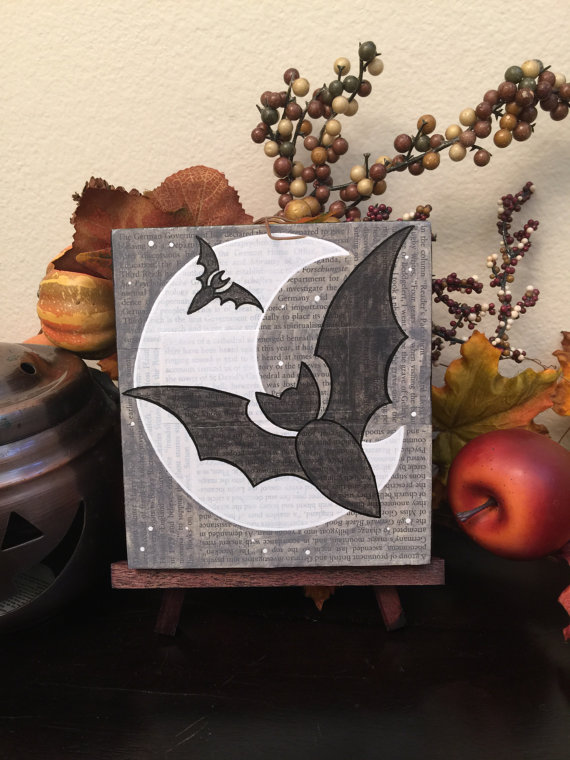
Crescent Moon and Bats
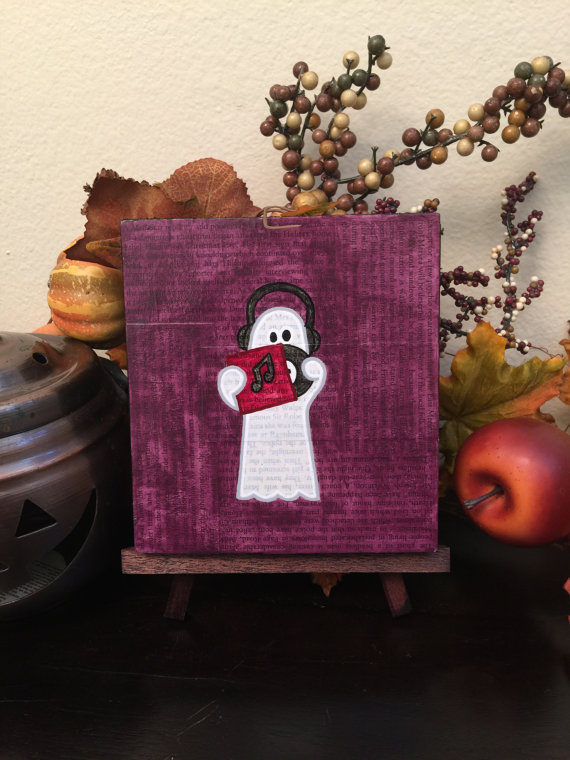
Ghost Listening to Records
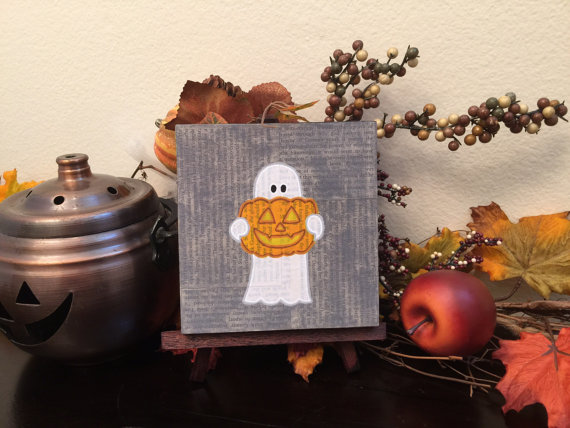
Ghost with Pumpkin
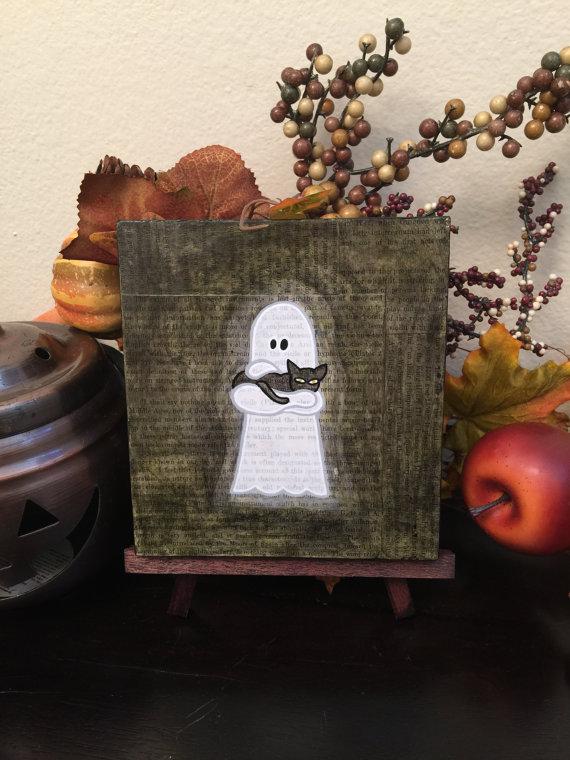
Ghost Holding Cat
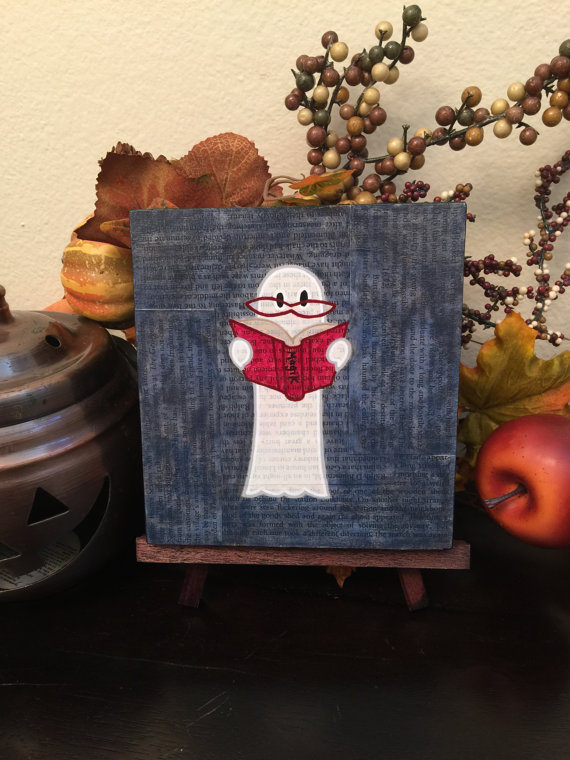
Ghost Reading a Book
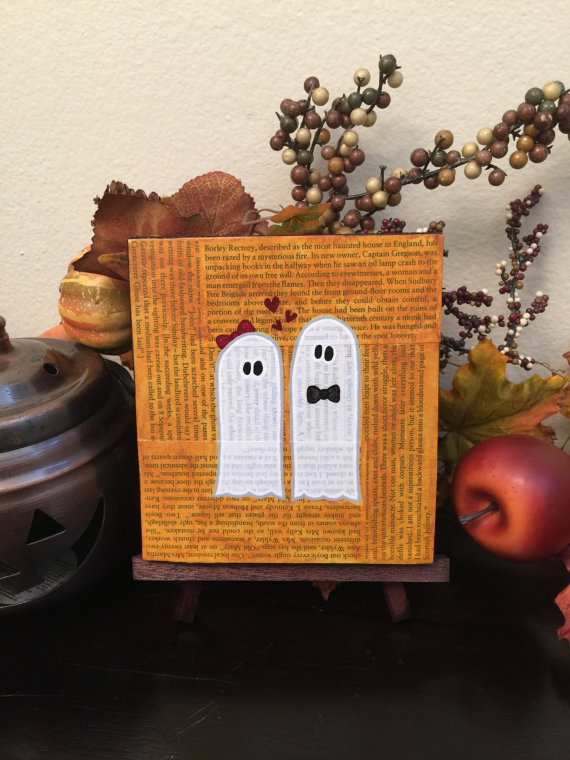
Ghosts in Love
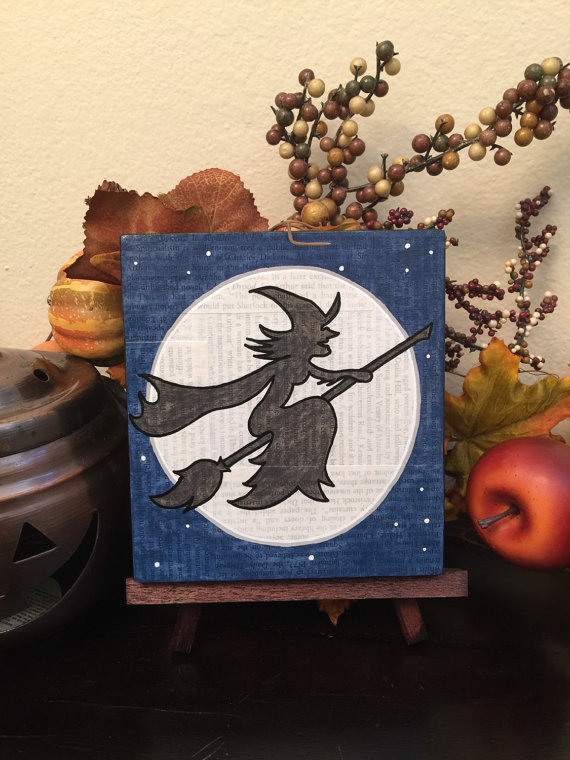
Full Moon and a Witch on a Broom
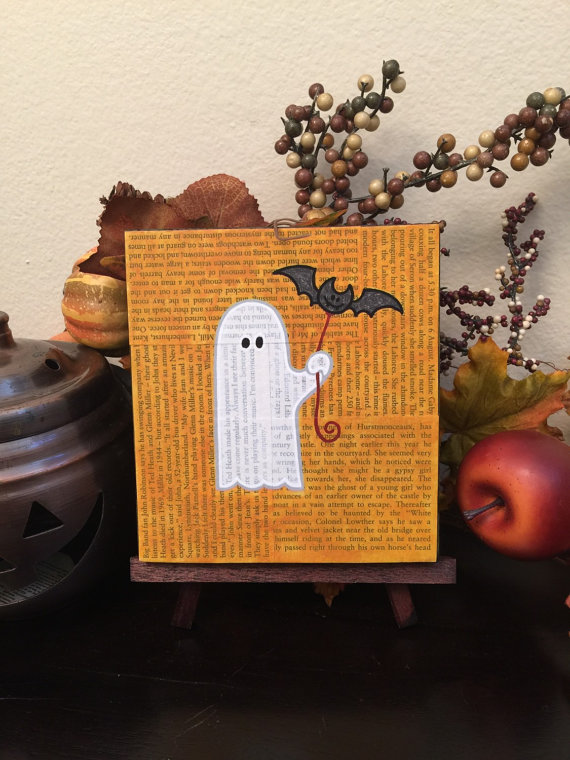
A Ghost and Its Bat
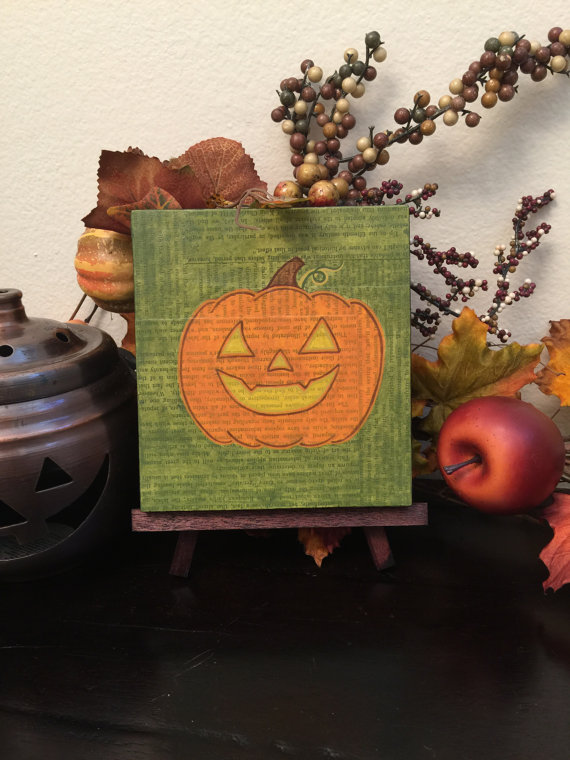
Pumpkin
There’s more where this came from, which we’ll add to the store as they’re ready. The plan is to keep releasing new creations through The Mystery Barn Trading Co. as we go, including another possible line of creations at Christmastime and some more surprises. We hit 100 likes for the Mystery Barn Trading Co. Facebook page within a few hours, and we’ve been having fun taking our first steps into joining the New Creators + Makers ourselves. Stay tuned!

One of the projects I’ve been working on at the Annenberg Innovation Lab is a study of The New Creators + Makers, where my team of students and I have been looking historically at the career trajectories of creative types, what commonalities exist across multiple creative industries (career stages, challenges, opportunities, etc.), and how new technologies are helping or hindering those common areas. This work is culminating in a big Think & Do event this fall in Chattanooga, Tennessee, where lab sponsor EPB offers a ludicrously high-speed Internet connection, which makes even more of these opportunities possible via long-distance collaboration, real-time work in the cloud, high-definition 360-degree experiences, and so on.
This past week a number of articles and other resources on the business of comics crossed my desk, so I thought I’d share a couple of them here for your enjoyment or edification (and my own later reference):
- SKTCHD Survey: What’s the Life of a Comic Artist Like?
“Over the past month, 186 artists anonymously responded to questions about who they are, what they do, how much they earn, which publishers they had the best experiences with, and much more in an attempt to provide a clearer picture as to what their lives are like. The plan for this project is to bring it back each year to deliver an evolving view of how artists live and how things are changing for them in this time of industry boom, while refining it as years pass. It starts with this first survey, though. The hope is an effort like this might give publishers, writers, readers, reviewers and up-and-coming artists a more comprehensive view of a world they may not fully understand.”
“When you’re talking about what the typical respondent looked like, they were male, between 26 and 44 and from the United States. Those three segments were by far the largest, with each accounting for over 65 percent of their segments. That said, there was still solid diversity within the mix, with over a quarter of respondents being women and over 20 percent of them fitting into the tiny 19 to 25 age group. The United States and three other countries—the United Kingdom, Canada and Ireland—dominated the results for country of origin, but the survey had quality reach, with respondents from 19 countries in total.”
“48.2% of respondents earn less than $12,000 a year, which means they are at or below the poverty line from income related to their comic art. It doesn’t get much better from there as over 66 percent of respondents earned $25,000 or less from their art. 5.4 percent earn six figures off their art, but that’s a small part of an ugly piece of pie.”
“Almost 60 percent of artists who responded shared they can’t make a living off their work. What that means is many artists live interesting double lives. While many mentioned that they did freelance illustration, animation, advertising work, storyboards or other art related jobs to supplement their income, there were others who worked in factories, as bartenders, or even in one special case, lived off earnings as a figure drawing model and a tarot card reader. Others bring in income from alternative sources, including working in a shared income household with a spouse and leveraging Patreon and other crowd-sourcing outfits to help them get by. Artists may not be making the big bucks, but they are a resilient and resourceful group.”
- Kieron Gillen on “Is The Wicked + The Devine in Trouble?”
“To save you clicking through, the answer is ‘No.’
The slightly longer answer is ‘While I generally object to jumping on a singular writer when talking about a larger issue which I see all over industry commentary columns, if you think that you can look at WicDiv’s sales and think they’re in any way in trouble, you have no business writing an industry commentary column. You simply don’t know enough to be doing this, and in doing so, you are hurting people’s perspective of the industry.'”
“Anything selling stably over 10k in single issues is a cause for celebration and joy. The creators are almost certainly extremely happy.
If you’re selling over (ooh) 12k, you’re probably making more than either of the big two would pay you, unless you’re one of the very biggest names.
If you’re selling anything near 20k, you probably have to buy drinks for your friends.”
“None of the above includes digital sales.
None of the above include trades. You throw trades in, and you change everything entirely. A cursory look at hit indie comic numbers reveals that their trades sell much more than Marvel/DC main universe trades, with a few exceptions (There’s a reason why Matt and David’s Hawkeye was such a big thing, and it wasn’t its monthly sales). Let’s bold another sentence.
You cannot do an industry commentary column on indie books without including the impact of trades.
There are books that are selling well beneath 10k and are doing just fine.
All the three sentences I bolded in a block were about making money from the single issues. They do not include any other revenue source, such as trades. If the single issues break even and you make your money in trades, that’s also fine. With a few exceptions, big two comics primarily make their money in single issues. That is one reason why their single issue sales matter so much more.”
- The Beat: How to Break Into Comics and Survive Once You Get There.
There’s tons more here. Less of an article itself and more of a list of other really great articles and resources.

…And just like that, six months have gone by. Let me ‘splain. No, there is too much. Let me sum up. In the past six months, I’ve:
- Co-taught the Annenberg Innovation Lab’s 2015 CRUNCH Student Design Challenge (an intense crash course in entrepreneurialism) with Erin Reilly, Francesca Marie Smith and Ian Donahue
- Guest-lectured on transmedia storytelling for Lipscomb University in January
- Guest-lectured on transmedia storytelling and branding in Henry Jenkins and Burghardt Tenderich’s Transmedia Branding course at USC in February
- Attended the E2 Conference at USC in February
- Presented a panel on “Storytelling with The New Screens” with Alisa Katz and Francesca Marie Smith at SXSW in March
- Hosted a panel on “Hollywood Does Cutting Edge” at Digital Hollywood in April
- Co-ran the “Cyberpunk 2.0: Worldbuilding and Storytelling” workshop at the Cyberpunk: Past and Future USC Visions & Voices event with Jeff Watson
- Was a keynote speaker at the Media Mutations 7 conference in Bologna, Italy in May
- Presented a three-day workshop on transmedia storytelling at Danube University Krems in May
- Hosted the “Storytelling with the Internet of Things” workshop with ioTheatre at the Annenberg Innovation Lab in June
- Attended E3 in June
And those are just the big, professional events! In “somewhat smaller” professional things, I’ve been doing a bunch of work through the Annenberg Innovation Lab for our sponsors, including some really fun stuff involving how to leverage different types of fan engagement, doing franchise development, and storytelling with even more New Screens. The biggest thing on the personal front, in addition to enjoying the hell out of being a dad and doing my best to train my daughter for a bright future in supervillainy, was packing up the family and moving from San Pedro, California (which was at the southern end of the 110 N-S highway that bisects Los Angeles) to Pasadena, California (which is at the northern end of the 110 highway). Yes, that means that we literally drove from one end of the 110 to the other multiple times this spring, frequently in a U-Haul truck. Good times, good times.
But now it’s summer, and things are starting to ease up, right?
Right?
Well, no. Not even a little bit. Because now I’m writing my ass off, trying to finish up a couple major projects before things get really zany starting, oh, in just a few all-too-short weeks… I’ve got one really big piece of news pending that I’m not quite ready to announce yet. Soon! Very soon! (Man, I need to get back into the habit of blogging, sharing pictures and engaging on social media! Nothing like working for a big enormous company with its squads of flesh-eating lawyers to break you of oversharing…)
Posted in Academia, AIL, Life, Media, Tangible Storytelling, Teaching, Technology, Transmedia, Travel, USC, Wearables, Writing
|

I’m writing this first blog post of 2015 from a hotel room high in the Riviera hotel, overlooking the delightfully bizarre wonderland that is Las Vegas. I’m in town to participate in the equally delightfully bizarre wonderland that is the Consumer Electronics Show, checking another item off my personal bucket list. Yesterday afternoon my labmates from the Annenberg Innovation Lab and I gave a panel discussion at the Second Screen Summit, which was a huge amount of fun.
Here’s our panel description:
3 – 3:30 p.m.
Innovations in Storytelling & Media
The media and entertainment industry has become increasingly complicated as TVs and movie screens are joined by computers, tablets, and mobile devices. As wearables like Google Glass, virtual reality devices like the Oculus Rift, and smart objects, homes and cities are added to the mix, it’s time to ask: How do we best create, engage with and spread content when everything becomes a screen? Researchers and directors from the University of Southern California’s Annenberg Innovation Lab will share how storytelling and media will change in the next 3-5 years, including how storytelling and play will evolve through smart toys linked to transmedia worlds, the new opportunities and challenges of virtual reality and immersive media environments, and the potential of wearables as the next frontier for media and entertainment.
Moderator:
Prof. Jonathan Taplin, Director, Annenberg Innovation Lab, USC
Panelists:
Geoffrey Long, Technical Director & Research Fellow, Annenberg Innovation Lab, USC
Erin Reilly, Creative Director & Research Fellow, Annenberg Innovation Lab, USC
Francesca Marie Smith, Provost’s Fellow & Doctoral Candidate, Annenberg Innovation Lab, USC
The panel went very well, and afterwards Kevin Murphy – the showrunner of Defiance – complimented me on what I said up there. As a fan of his show and his work in the transmedia space, I blushed all the way down to my socks. That was a very good day.
365 Good Days
Good days are something I plan to focus more on in 2015. The end of 2014 was, quite frankly, really awful. Not only did one of my best friends on the planet pack up and leave LA, but my grandfather suffered a stroke on Christmas Eve, spent the following week fading away in the hospital and then finally passed on New Year’s Eve. That one-two punch really clarified two things:
- life really is short, so make the most of it every day
- every day can be a good day if you work to make it so and focus on the good stuff
They may be psalms from the Hallmark Card school of wisdom, but that doesn’t make them any less true. So, one of my big 2015 New Year’s Resolutions is to focus on the positives, and to grab reality by the lapels and make it better. I’ve been privately practicing the “365 Good Days” exercise, where you take a little time and write down the good things that happened each day, but I’ve also been working with a renewed vigor to make each day as awesome as possible. We’re almost a week into 2015, and I’ve connected more with my family, enjoyed some mind-blowingly amazing food (yes, Erin and Francesca, the pop rocks sushi at Yellowtail at the Bellagio was unlike anything else I’d ever had before, but the High Steaks [sic] roll and the vanilla white chocolate cherry mousse were two of the best things I’ve ever tasted) and even been more productive.
 vanilla white chocolate cherry mousse from Yellowtail vanilla white chocolate cherry mousse from Yellowtail
To that end, I’d like to share here part of a Statement of Purpose essay I had cause to write late in 2014. I’ve been thinking a lot about the phrase “The Future of Storytelling” and how it can function as a multifaceted structure for my work, and what I’m passionate about, and I think I’ve struck upon something really useful for all of this thinking along these lines.
A (Re)statement of Purpose: On the Future of Storytelling
Let me tell you a story.
I was the only kid of an only kid, growing up in a pre-Civil War farmhouse out in rural, middle-of-nowhere Ohio. Not only did I not have any siblings, I didn’t even have any neighbor kids within walking distance for years. What I did have, however, were brilliant, creative, generous parents who must have believed that the second best thing to siblings were stories. Our house was always packed with books, including the myths, adventure stories and Classics Illustrated comics that my grandparents had given my mom when she was a little girl, and I would lose myself in those tales for hours. Meanwhile, my Dad would smuggle reams of copier paper out of his office and home to me, and I would joyfully fill them up with stories and drawings of my own.
This blend of solitude, stories, and supplies was the perfect recipe for making a highly creative (if admittedly slightly weird) kid. Not only would I write and illustrate my own stories, but Dad and I would go into his office after hours, run off a pile of copies on their Xerox machine, and then hand them out to all my elementary school friends the next day. Before long my friends were making stories and art of their own, and I was happily bundling all our stuff up together into funny little proto-zines.
My fate was really sealed, though, the day Dad brought home not paper, but an Apple II computer.
Keep in mind that this was the early 80s, so this beastie was a beautiful, monstrous contraption that whirred and clunked and flickered tiny, blocky green letters across its TV-like, bulbous, black screen. At first I didn’t know what to make of it, but then I discovered what I could make with it: stories, and new kinds of stories at that. Now I could create stories that asked the user what they wanted to do, and make images that moved! I taught myself just enough BASIC to build my own crude interactive fiction pieces, illustrated with equally crude ASCII art. It was my favorite toy, right up until my Dad brought home something even stranger: a second computer, but one with the monitor, the disk drive and the CPU all fused together into one blocky chassis. It was the first time I’d laid eyes on a Mac, with its wonderful little mouse and its glorious Graphical User Interface. A few years (and a few computers) later, I was exploring mind-blowing games like The Fool’s Errand, The Manhole and Myst, and using equally mind-bending tools like PageMaker and HyperCard to create even cooler zines and interactive storyworlds of my own. This co-evolution of storytelling and technology would become the recurring theme of my life.
My crude little zines grew into Inkblots, a full-fledged “literature, culture and technology” zine I created for my creative friends at my high school, our friends from other schools across Ohio, and, once I discovered AOL, other similar-minded kids from around the world. I went on to earn my bachelor’s degree from Kenyon College, complementing my time in its presitigious creative writing program with endless hours geeking out in an experimental proto-digital humanities program where, instead of traditional papers, I created things like CD-ROMs and QuickTime VR experiences. After graduation I landed a job as a graphic designer for a medical best practices research firm, where I quickly became their first web designer and then web producer. That led to my starting up my own digital design and copywriting consulting company, and I began producing short films in my spare time with my friends. After a few years of that, I was fortunate enough to be accepted into the Master’s program in Comparative Media Studies at MIT, one of the most transformative experiences of my life.
At MIT I studied under Henry Jenkins, researching the emerging aesthetics of transmedia storytelling (in which stories are strategically crafted to unfold across all kinds of traditional and new media) and I helped co-found both the Convergence Culture Consortium and the Singapore-MIT GAMBIT Game Lab. My work in transmedia storytelling and video games got me drafted by Microsoft, where I would spend a few years first as a member of a “future of media and entertainment” think tank under the company’s CTO/CXO (where I had a hand in the creation of both the Xbox One and SmartGlass) and then as a cofounder of the Narrative Design team (where we worked to create vast storyworlds the size of Halo that would unfold across Microsoft’s entire entertainment platform, including those screens that don’t exist yet). After leaving Microsoft, I followed Professor Jenkins down to USC, where I now serve as the Technical Director and a Research Fellow for the Annenberg Innovation Lab. Even now, I’m still following the same theme of weaving together storytelling and new technology, exploring how stories might be told with such “new screens” as 3D printers, virtual reality, augmented reality, connected homes, connected cities, wearable devices, the Internet of Things, and so on – but now I’m also studying how technological disruptions in the Media and Entertainment industry change how storytellers make a living.
“The Future of Storytelling” almost perfectly sums up my life so far, but it also nearly perfectly encapsulates what I’m trying to do moving forward. It’s my driving purpose as a storyteller, a technologist and an educator, depending on which part of the phrase you emphasize.
- The Future of Storytelling. Storytellers become hyper-aware of how stories and culture impact one another. Humans have always used stories to pass along knowledge, to share techniques for survival and for better understanding the world around us. As things both change and stay the same, so too do the stories we tell each other. What are the lessons, both timely and timeless, that we will need to share? How does an increasingly globalized culture change what cultural tales we share and enjoy? What new fears and hopes will lead to new stories? What new storyworlds will capture imaginations so completely that they become philosophies, reshaping the world? What are the stories that we will want to tell and be told?
-
The Future of Storytelling. Much as I discovered when I first laid hands on a computer, the tools we use can shape the kinds of stories we can tell. Old media never go away – video never did completely kill the radio star – but new media do create new opportunities. Further, some storytellers have such creative visions that they need to invent wholly new media to realize them. How do the media we use to tell our stories shape the stories themselves? What kinds of stories lend themselves particularly well to certain media like books, comics, movies, TV shows or video games? What kinds of stories can now be told using such “new new media” as smart objects, wearable devices, 3d printers, ubiquitous computing, or virtual reality? How will the ways in which we tell stories change?
-
The Future of Storytelling. Perhaps most importantly, who will be the next generation of storytellers? What skills will they need? How will traditional storytelling, worldbuilding and media-making techniques combine with new forms of artistry to create wholly new, even revolutionary works of art? How will these new creators and makers find their audience, in an age of content supersaturation? What new business models and practices will they need to embrace to not just survive, but flourish? Who will teach this next generation of storytellers, and what will they need to be taught?
My daughter is, at least as of this writing, also an only kid. Every day I try to pass on to her the same love of stories, art and creativity that my parents instilled in me. My dream is to do the same for as many others as possible, continuing my own experiments and explorations into the future of storytelling and sharing what I create and discover. My eventual goal is to practice, consult and teach, founding a Future of Storytelling Laboratory or Workshop where likeminded storytellers can come together to collaborate on even bigger, more valuable and more meaningful innovations and works than any of us could do alone. I deeply believe that, to paraphrase both Abraham Lincoln and Peter Drucker, the best way to predict the future of storytelling is to create it.
So that’s what I’m working so hard to do, in 2015 and beyond. Happy New Year, everyone, and may all of us enjoy 365 good days this year!

November 25, 2014
3:45 pm
I’ve been thinking a bit lately about storytelling with smart homes and the Internet of Things – what the MIT Media Lab‘s David Rose calls enchanted objects. My Lighthouse in the Woods experiment at the Annenberg Innovation Lab was a first step in this direction, using the Oculus Rift to experiment in storytelling using smart picture frames in a living room:
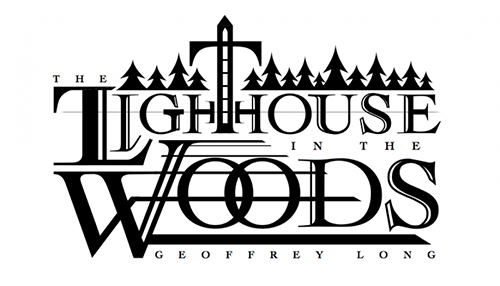 The Lighthouse in the Woods is an immersive ghost story. Donning an Oculus Rift, the user finds herself locked in a windowless study as a disembodied voice tells how, one by one, the narrator’s family fell victim to a mysterious curse. Portraits on the walls illuminate as each family member is introduced, dim as each one falls, and re-illuminate as they come back. The audience member can move around the room, but cannot leave it, and has no control over how the story progresses – replicating the narrator’s experience of impending doom and helplessness.
The Lighthouse in the Woods leverages the Rift’s unique sense of 360-degree immersion, but by removing nearly all of the audience’s agency, it subverts the assumption that the Rift is a gaming device and delivers a storytelling experience more akin to film, TV or theater. This project also explores how storytelling could evolve for a connected home. The Lighthouse in the Woods uses portraits to tell its story because connected digital picture frames are one possible additional “screen” to use in a living room.
It was a fun experiment, and it gave me an opportunity to work with some old friends (huge props to Talon Beeson, Jesica Avellone, Sara Anderson, and Andy Rozsa) and some new ones (similarly huge props to USC Games’ student Austin Drexler), but it barely scratched the surface of the topic.
Since Black Friday is this week, I’m seeing a ludicrous amount of ads for sales on smart home tech, which is probably geek dad bait of the highest order. Since we only rent our place, this particular geek dad is limited in how much I can really drill into this subject (har har), but if we did own this joint I’d first be tempted to install some of the more utilitarian stuff: a Nest thermostat and smoke detector set, for example, or some simple equipment to tell me if the mail’s arrived or if the garage door is closed. (Rose’s excellent chart aside, I suspect there’s a pretty clear Maslow’s hierarchy of needs for the Internet of Things.) However, once that was sorted, I’d definitely want more fun stuff in the house. I keep thinking about the possibilities of the house as a storytelling and entertainment platform, which leads to more thinking about how a home already functions as a storytelling engine.
Think about it:
- Framed pictures are stories. Photographs are captured memories. Paintings are captured visual stories.
- Kitchens and pantries are full of stories. Many of the recipes we cook are handed down to us over generations. The leftovers in our refrigerators are memories of places we’ve been. Many of the packages of our food tells the stories of where that food came from (true or not, that’s a different matter).
- Cars accrue memories. Not only do beautiful vintage cars have stories of prior owners, but all cars have embedded stories about how they were designed and where they were made. Dings on their bumpers tell stories of fender benders. (In my case, somewhere out there is a car with a story about backing into a piano.) Family cars could tell brilliant stories about family vacations, especially cross-country drives.
- Toys tell stories. Of course they do.
- Clothes tell stories. Much like food, many clothes have stories attached to their brands, although the actual stories of where they were made may be much less romantic. Still, shirts can be souvenirs of concerts or other locations; jewelry commemorates occasions; unique items can represent the skill and story of an artisan.
- Furniture can literally tell stories. I’ve sketched up a device I call the Storyteller’s Clock, which would rattle off a story for every day of the year…
- Lighting can tell stories. Or, at the very least, it can set the stage for other stories to emerge (hello, mood lighting).
- Architecture can tell stories. Every home has a story about who built it, when and why. The manner in which houses are designed and built reflect certain cultures or periods of time. The more artistic ones can themselves evoke particular moods or create their own little worlds (think homes that look like castles). Homes converted from other buildings, like warehouses, barns, windmills, and so on, are full of stories from their previous lives.
When you look at a home through a storyteller’s lens, you begin to realize that homes (or at least the most interesting ones) have stories everywhere. There are a couple things, though, of particular interest.
One, many of these stories are a balance of push and pull – the pictures and souvenirs in a house, for example, may be completely silent and ignored until you invoke stories when you choose to look at them – for example, many of the pins shoved into the bulletin board over my desk are souvenirs from our honeymoon at Walt Disney World, but a few are souvenirs from the opening of OSU’s Billy Ireland Cartoon Library and Museum last year, another’s from the 2010 Game Developer’s Conference, two more are from Artist’s Alley at the San Diego Comic-Con, two more are from a trip to San Francisco this year, a few are collector’s pins from the Broodhollow Kickstarter last year, one’s from a Cirque du Soleil show, one’s a rare Walt Disney Imagineering Blue Sky Cellar pin my wife got me, and another’s a rare Imagineering pin I was given as a thank-you for doing a little work for Imagineering last year. However, these items need me as a translator. When this office serves as a guest room, few people would know what the stories behind these pins are, unless I (or, in some cases, my wife Laura) were there to tell those tales. I keep thinking of the scene near the end of Return to Oz, in which Dorothy has to go through the Gnome King’s ornament room, lay her hand on an object, and say “Oz” – if the object is actually one of her friends, transformed by the villainous Gnome King into a true enchanted object, then the friend would be changed back. What if a visitor in this guest room could lay a finger on one of the pins on my bulletin board, say the equivalent of “Oz”, and hear – or somehow even see – the story behind it?
Two, I think the kitchen is actually a great place to tell stories with a smart home. Something like SARAH, the Self Actuated Residential Automated Habitat from Eureka, could sort of cook, or at the very least do an ingredient check in the pantry. We’re starting to see steps in that direction with things like Microsoft’s Kinect or Amazon’s Echo, which will clearly hook into things like Apple’s Siri or Microsoft’s Cortana really quickly. Asking a smart house to cook a meal is beyond us for the time being, but we could – and can – ask it to start the coffeemaker. However, hooking up a little screen with speakers in the kitchen that could, upon scanning a barcode or detecting some other NFC widget, play a little video of your grandmother saying where a recipe came from, or some celebrity chef explaining where the inspiration for this particular TV dinner came from, would be low-hanging fruit. There’s even a possibility of making the cooking itself into a narrative experience, either as a kind of extended metaphor a la the whole “rabbit runs around the hole” thing when you’re teaching a kid how to tie her shoes, or as a play-by-play by a really great storytelling chef like Julia Child, Anthony Bourdain or Jamie Oliver, explaining how they learned to cook this recipe.
Three, and again this gets back to my Lighthouse in the Woods prototype, I think there’s a lot of room for storytelling experiences in a smart house without screens. Imagine playing a game of hide-and-seek with a virtual cartoon mouse that scampers throughout the house via embedded speakers, “rustlers” akin to the vibrate function on a phone, or tiny projectors. Imagine a ghost story told in a similar fashion, or a romance, or a drama. Imagine an installation-style murder mystery, or something like Sleep No More or Then She Fell, the installation stories from Punchdrunk, only with the actors projected into the room? Could you tell a similar story with disembodied voices coming from location-aware speakers? What happens when you layer AR into the mix?
Four, what happens when you add performative objects, like the next generation of Teddy Ruxpin dolls, as “actors” in the experience? We’ve done a little experimenting with this at the Annenberg Innovation Lab already (more on this in a bit, once it’s fully unveiled) but imagine a whole network of smart toys that are aware of each other and react to each other, like Skylanders without a TV, built on a platform similar to the one I hypothesized over ten years ago? Imagine the Beauty and the Beast style experience you could create.
Five, what voice would you want your house to have? Getting back to the Siri and Cortana thing for a moment, would we still want our house to be an AI of sorts if we’re already carrying an AI around in our pockets? Would we want our house’s AI to be a slightly stuffy librarian, and our phone’s AI to be a wisecracking raven? Perhaps we would want multiple AIs haunting our houses, so we have a chef AI character installed in the kitchen to help with the cooking, a mechanic AI character in the garage to ask for help with the car, and a fashion designer AI in the closet to make suggestions on what to wear? What stories would they all tell? How does the modularity of separate AI characters impact how we think of them – would we feel shortchanged if we had to pony up for a separate AI for each function instead of simply buying one master house AI like J.A.R.V.I.S, or would we feel weirder if we knew our JARVIS was incomplete because we hadn’t bought the “mechanic” DLC pack to make him more useful in the garage? What if those DLC packs were themselves stories for our J.A.R.V.I.S. to learn?
Anyway, this is the kind of thing I’ve been thinking about lately. How would we Imagineer our everyday homes? What would that experience platform be like? Our houses are already full of stories, but what would you really want your house to do if you were to say aloud, “House, tell me a story”?
I just tried it. Surprisingly, I’m a little disappointed it didn’t respond. Maybe that in itself is telling me something.

November 18, 2014
2:44 pm
On October 23rd, I had the great pleasure of co-hosting Geek Speaks: The Future of Comics with Henry Jenkins.
I was thrilled to not only reunite Henry with the one and only Scott McCloud for a one-on-one discussion on McCloud’s Reinventing Comics almost 15 years later, but to then get to chair a panel of really brilliant respondents immediately afterwards.
I’ve posted a Flickr album of the event here, and you can find video of the event (although admittedly low-resolution for the time being – we’re still trying to get the high-res versions up) on the Annenberg Innovation Lab’s Vimeo page. Here’s the currently available version of Henry’s conversation with Scott:
Once they were done dazzling the audience, it was my panel’s turn. My panelists included:
Here’s the video of our half of the event:
At the heart of much of our conversation was a simple question: “What is the Future of Comics?” I didn’t get to really tuck into some of the more outlandish ideas I’ve got about where comics could be going (especially in virtual reality or augmented reality), so I’d like to republish here an excerpt from the talk I gave last year at the Grand Opening of the Billy Ireland Cartoon Library and Museum at Ohio State. This talk was presented via the gracious hosting of the good Jared Gardner, and was part of a one-two combo I delivered with my fellow transmedia geek and one time high school bandmate (how’s that for a small world?) Tyler Weaver as a setup for Henry Jenkins’ keynote lecture on “Reading the Yellow Kid”.
And now, a flashback to beautiful Columbus, Ohio on November 13, 2013 (I’ve put a Flickr album from that event here, to set the mood), and a jump-cut to the last third of my talk…
A Future of Comics, or, Ten Years of Combining Theory and Practice to Explore Transmedia Storytelling, Affordances, and the New New Comics
…Our projects at the Innovation Lab include exploring the emerging affordances of dynamic e-books, such as Moonbot, William Joyce and Brandon Oldenburg’s The Fantastic Flying Books of Mr. Morris Lessmore or Mirada and Cornelia Funke’s Mirrorworld. Because we’re a Think and Do tank, we’re applying what we’re learning from those works to our own experiments, such as the digital e-book project Flotsam, which mashed up David Wiesner’s beautiful illustrated children’s book with a rich interactive experience that utilized the iPad’s camera, its clock, and its other sensors in fascinating ways.
We’re currently booting up a new initiative at the lab we call the Edison Project, which posits that the media and entertainment industry is at its biggest point of change since Edison invented the Kinetoscope in 1891. The four primary research areas within the Edison Project are the New Creators and Makers, the New Metrics and Measurement, the New Business Models, and the New Screens – where, as the Technical Director and a media inventor style of storytelling geek myself, I’m spending most of my time.
The three big new screens we’re exploring right now are Google Glass, 3D printers, and the Oculus Rift. What’s exciting about these to me is that we don’t know what the affordances of these new screens are yet, and, I’d argue, the best way, or perhaps the most fun way, to discover those affordances is by getting our hands dirty and actually building stuff. Tinkering with Google Glass, 3d printers and the Oculus Rift will help us understand the “new new media” of augmented reality (AR) storytelling, tangible storytelling, and virtual reality (VR) storytelling, and then, for this group’s particular area of interests, perhaps even a “new comics” – AR comics, tangible comics, and VR comics.
AR Comics
Now, we’ve seen AR comics before. Marvel launched its “Marvel AR” initiative at the South by Southwest conference in 2012, and Skip Brittenham and Brian Haberlin’s gargantuan augmented reality-enhanced original graphic novel Anomaly was published in 2012 and was sufficiently well-received, or at least sufficiently conceptually impressive, to be optioned for a feature film by Relativity Media in September of 2013.
These AR experiences share a common mechanic: when a digital camera is pointed at a printed page, a lightly animated 3D model appears as if by magic, superimposed over the page. Google Glass could certainly do something similar – but there are some emerging affordances to wearable AR headsets like Glass that suggest that AR comics could offer quite a bit more.
For starters, Glass relies on a primary UI similar to a kind of “picture in picture” for the real world. The user sees a translucent screen superimposed over the upper right corner of their vision, which the user then swipes through left and right using a touchpad on the frame beside their right eye. Seeing this in action, the temptation to experiment with panel-by-panel comic strips, perhaps with its advancement triggered by a simple blink, is irresistible.
That’s interesting, but let’s go more blue-sky. As the technology advances to overlay more than just one corner of your vision, and as computer vision tech advances for more nuanced recognition of patterns in the real world, it’s possible to imagine a system that composites comic book panels over white spaces in the real world. Sitting in a hotel, an advanced set of AR glasses could overlay panels of a story reshaped dynamically in a way similar to what we did with Ryse, cropping and zooming large panels into dynamic sizes customized for your walls – which will, of course, call into question how “fixed” or dynamic the layout and composition of these images could be to have them still be considered comics.
Either way, what’s funny is that, even if we don’t yet know the full affordances of storytelling with a “new screen” like Google Glass, such explorations of what it means to tell stories, or to make comics, using such new screens helps us to fill in those gaps, to figure out what those affordances of this new medium might be. Again, learning through getting excited and making things.
Tangible Comics
The term “tangible comics” is admittedly idiotic, because traditional paper comics are already tangible. However, in this case we’re inheriting the term from the concept of tangible computing, or, as it’s more popularly known, the “Internet of Things.”
Much of the buzz surrounding this emerging tangible computing space is focused on the 3D printing movement, and rightly so. Early experiments bashing together 3D printing and comics are really interesting – for example, Wizards and Robots from Intel’s resident futurist Brian David Johnson and the Black Eyed Peas’ resident futurist will.i.am includes such transmedia extensions as multiple print artifacts delivered encased in a 3D-printed “crystalline” container.
Perhaps more interesting, at least to me, are the possibilities offered here to update the same “toys + comics” area that I covered in my aforementioned application essay to MIT. This bundling of comics with toys is being currently revisited by Hasbro’s Transformers toys, some of which now include full-sized issues of IDW’s Transformers comics which, much like Mattel and DC’s Masters of the Universe mini-comics from the 1980s, each offer up a story starring its co-packaged action figure.
Where this gets interesting is where we look at the emerging practice of 3D printing really detailed, beautiful custom action figures. As 3D printers continue to increase in their fidelity, and inevitably begin printing in multiple colors with multiple materials and textures, it’s only a matter of time before, instead of toys coming bundled with comics, we’re buying comics that are bundled with exclusive downloadable toys that we’ll print at home.
Again, these are still early days, but tinkering in these directions will begin to help us understand an emergent set of leverage-able affordances for tangible storytelling.
VR Comics
Not a lot of people are experimenting with comics and virtual reality yet – Google “comics AND Oculus Rift” and you get a strip by Scott Johnson about a poor guy joyfully immersed in a VR game while a villain lifts his wallet.
Perhaps this is because, much like “tangible comics”, the idea of VR comics seems antithetical to comics at all. For a clue as to how this might work, consider the approach one Korean company took in developing an app called VR Cinema 3D, which is pretty much exactly what it sounds like – a virtual reality cinema, in which the user can watch regular movies, but without the pesky kids on their dratted cell phones.
That said, simply holding up a virtual comic page in virtual reality is, well, virtually useless. So push it further – what if each panel of a comic could be fully immersive, so the user could choose to step through the frame and wander around each panel in 3D space, so each panel becomes effectively a life-sized, enormous virtual diorama? If that diorama is static and doesn’t use spoken text, but instead employs giant floating 3D text balloons, could they still be recognizable as comics?
Again, it is through such experimentation, such critical making, that we will come to understand what virtual reality will have to offer us as storytellers.
The Next Transmedia Comics
What’s especially interesting here is that this last scenario, as weird as it sounds, isn’t that farfetched. Imagine the next generation of transmedia artists, who don’t want to tell transmedia stories using just comics or games or videos, but also AR, tangible artifacts and VR?
It’s now becoming possible to boot up transmedia mini-production studios. Much like how Adobe’s Photoshop became rapidly repurposed from a photo editing tool into the de facto Swiss army knife of multimedia design, Unity is becoming a de facto Swiss army knife for next-generation transmedia experiences. Art created in programs like Photoshop and Autodesk’s Maya can be imported into Unity, and then exported out into games, videos, virtual reality environments like those used by the Oculus Rift, and even 3D printable toys and artifacts. Within the next 5 years or so, this kind of transmedia production studio may well become the new desktop publishing, and ‘indie’ transmedia stories could become much, much more expansive.
Conclusions and Takeaways
So what’s next? Long story short, right now at the Innovation Lab we’re looking to:
- Explore these new screens
- Discover their new affordances
- Observe what new story experiences emerge
- Prototype, prototype, prototype!
In other words, to get excited and make things! Thank you!

November 16, 2014
12:18 pm
I took some time this weekend to update my portfolio. Some highlights:
Interactive
Print
Identity

September 10, 2014
8:40 am
It’s no secret that I’ve been an Apple fanboy for a long, long time. I’ve always owned, used, and loved Macs, and my few dark experiments with Windows, Linux and Android have never (at least, not yet) ended well. I was definitely among the throngs feverishly awaiting Apple’s foray into the wearables market, and when they began setting up yesterday’s big event as something as revolutionary as the original iPhone, I began to hope. Could they transform the wearable space as deeply as they transformed the phone space with the original iPhone?
Spoilers: No.
Sure, I got a little choked up when Tim Cook said “one more thing”, but the Apple Watch (and I’m still having difficulty not referring to it as an iWatch) just isn’t that interesting. At least, not yet – hence the title of this post. It’s not that striking a design (I’m much more impressed by the daring roundness of the Moto 360), the UX seems like it might be unnecessarily complex (“digital crown”? really?) but most of all, I have a very simple rubric that I use when I see a piece of new tech that this thing seems to fail. I ask myself, first, “Does this solve a problem?” and then, “Can I tell, or be told, new types of stories with it?” The answer to both is, again, not yet.
I was one of the early backers and adopters of the Pebble smartwatch. I wore it proudly for a few weeks, but I was mostly deeply enamored with its option to show the time in words. I also really liked the notifications, so if someone was calling me I could see who it was without having to fish my phone out of my pocket – and, as of this moment, that’s the one thing where the Apple Watch will thrive for me. I’ve also played with the Fitbit and Nike+, but like the Pebble, after a few weeks they both wound up in a drawer instead of on my person. They weren’t transformative enough, at least not for me. The Fitbit didn’t really prompt me to walk that much more than I already do, instead just turning into a constant reminder that I am, if not lazy, then chronically overbooked. (It’s not exactly easy to justify taking the time to go for a walk when you’re under constant deadlines, and having a device nag you that this is literally killing you doesn’t help…)
Anyway, back to the topic at hand. Or, well, wrist.
What kinds of new storytelling or entertainment experiences will wearables light up? The answers for that come out of the woodwork when you’re talking about Google Glass, even though very few people have actually built those experiences yet (which is why I remain super proud of my lab’s Augmented Accessibility and Augmented Storytelling projects). For a wristwatch, though, it’s trickier. I have a project that I’ve been bandying about for a wearable storytelling experience that’s similar to Samurai Jack meets Six to Start’s Wanderlust, where chapters of a story of a hero’s long wandering walk are unlocked based on how far you yourself have walked each day, but such an experiment only needs the distance tracker, not necessarily a watch. In fact, the tiny screen on the watch may make delivering the story on the phone a much better experience, unless the story is purely aural and delivered over the headphones as you go (another experiment I’ve been drafting up).
I need to get my hands on an Apple Watch to see how it compares to some of the others, but as of right now, I’m still struggling how a wristwatch might function as a really great screen for storytelling or other entertainment experiences. Nintendo tried it with their Game & Watch devices way back in the day, and Pebble’s inched that way, but so far I’m still scratching my chin.
Must be time to make something. ^_^

When I was an undergrad, I enjoyed a Sundays-only subscription to The New York Times. Every Sunday we’d get a massive brick of content that essentially recapped the world’s happenings from the previous week. What if we tried that here, summing up the interesting stuff I’ve been enjoying lately? Let’s begin the experiment!
The New Screens
- Next for Virtual Reality: Video, Without the Games. “Silicon Valley is figuring out whether it can make this into more than a plot device in a science fiction novel. In April, a team of tech industry veterans from Flipboard, Google and other companies formed a new company called Jaunt that wants to bring what they call ‘cinematic virtual reality’ to life.” via The New York Times.
- Next for Virtual Reality: Video, Without the Games. “Imagine the possibilities of being able to swivel your head around within a movie, a news broadcast or a football game to see everything around a camera, not just what is in front. These aren’t the static 360-degree images anyone can see on the Street View function of Google Maps, but rather live-action motion pictures, rendered in immersive 3-D on a virtual reality headset. Silicon Valley is figuring out whether it can make this into more than a plot device in a science fiction novel.” via The New York Times.
- Immersive journalism: What if you could experience a news event in 3D by using an Oculus Rift? “USC fellow and documentary filmmaker Nonny de la Peña, for example, is creating immersive experiences that give participants an inside look at a news story, such as the war in Syria, or the military prison in Guantanamo Bay.” via GigaOM.
- The Future of Oculus Rift, According to the Man Who Invented It. “Looking way, way into the future Palmer [Luckey, the founder of Oculus VR and inventor of the Oculus Rift] sees a very different kind of Rift to the current set up full of wires and straps. ‘In the long run these headsets aren’t even going to be plugging into PCs, they’re going to have dedicated chip sets on the headset itself that are able to render a lot of different experiences. So when you can do that and you can make an easy user experience, you can make content that the average person is interested in, not a first-person shooter… As time goes on it’s not so much that VR is going to expand to other industries, it’s that the games industry is going to expand to do things in other industries. Whether it’s architecture or virtual holidays or film, the people that are making games, or making VR games today, are going to be doing these types of thing in the future’.” via Kotaku.
- Google Ventures Invests in Cinematic Virtual-Reality Startup Jaunt. “The funding from Google Ventures, the Internet giant’s independent and non-strategic VC arm, is part of a $27.8 million Series B investment round in Jaunt led by Highland Capital Partners. Also participating in the round were previous investors Redpoint Ventures, BSkyB, Dolby Laboratories chairman Peter Gotcher and Sling Media co-founder Blake Krikorian. The latest investments bring the startup’s total funding to approximately $35 million.” via Variety.
- Gartner Report Says 3D Printing Not Quite Ready for the Home. “In a report released earlier this week, Gartner suggested that the 3D printing of product models is two years away from its peak usage, while mainstream adoption of 3D printing for medical applications is about two to five years away. Although the technology is advancing and printers are coming down in price, the concept is not quite ready for everyday use in the home.” via ETCentric.
- Comcast Takes the Netflix Fight to College Campuses. “A new Comcast streaming TV service for college campuses, formally launched Thursday in a handful of schools, holds the promise of reducing schools’ bandwidth costs over time, college officials say. The service, which includes about 80 live channels and a robust on-demand library that can be streamed to tablets, phones and other devices, doesn’t require a physical set top box and is free for students with their room and board fees.” via The Wall Street Journal.
- Hand Gesture Armband Myo Integrates With Google Glass. “‘The question we’re exploring is: how can we find more natural ways to merge technology and people? We’re hitting the limits of today’s form factors whether they be personal computers, tablets, or smartphones. We believe wearable computing is the next progression in that evolution,’ [cofounder Matthew Bailey] says.” via Forbes.
- Apple iWatch: tracking the rumors of a Cupertino-designed timekeeper. “There won’t be a single Apple wearable device — or ‘iWatch’ as many observers have decided to call it — but rather multiple models at different price points.” via Verge.
- Style-Conscious People Can Power Up with Wearable Collection. “Q Designs has launched its flagship product, the QBracelet, a stylish unisex, lightweight accessory that has the ability to charge smartphones and other electronics. … According to Alessandro Libani, Co-founder and COO of Q Designs, ‘We conceptualized the QBracelet based on the idea that every useful object should be a beautiful object, and we believe that merging technology with fashion in smart ways will push the fashion industry forward.'” via PSFK.
- Netflix Hack Changes Colors of Living Room Lights Based on the Movie You’re Streaming. “A few Netflix engineers integrated the streaming service’s connected TV app with Hue connected light bulbs from Philips to change the colors of your living room light based on the movie you’re watching. This is similar to a recent SyFy experiment with Sharknado, but in Netflix’s implementation, the light color even changes while you navigate through Netflix’s TV app queue.” via GigaOM.
- Parrot’s new Bebop Drone promises out of body experiences and crystal-clear video. “Like its increasingly popular competitor, the DJI Phantom 2 Vision, the new Parrot flyer hopes to attract filmmakers and photographers with an increasingly high-quality flying camera, built-in GPS to fly programmed waypoints, and the ability to hover and pan the camera. But Parrot may also wind up leapfrogging DJI with unheard-of image stabilization and range — plus the officially-supported ability to use a VR headset while flying around.” via The Verge.
- Onscreen Text Messages Appear in Chinese Movie Theaters. “Select movie theaters in Chinese cities have begun experimenting with “bullet screens†(or “danmuâ€) — a new model in which audience members can comment on the film via text messages and have their impressions projected directly onto the screen. The experience is targeting young viewers who often have difficulty being away from their tablets and mobile phones.” via ETCentric.
- Irving Wladawsky-Berger: Reflections on the Future of TV. “Within media, I’ve been particularly interested in the evolution of television. The future of TV is being widely discussed in articles and workshops. Once upon a time, the term ‘television’ generally referred to TV sets, the TV programs we watched on those sets, and the TV networks that broadcast those programs to our sets. But, over the past few decades, and especially in the past 5 – 10 years, it’s much less clear what we now mean by the TV industry, let alone what it will encompass by 2025. The TV industry is being massively restructured as its companies keep searching for viable business models.” via Irving’s blog.
- OcuplusGlass, Guided Tours for the Oculus Rift Virtual Reality Headset Using Google Glass. “OcuplusGlass is a concept by developer Sander Veenhof in cooperation with interaction designer Klasien van de Zandschulp that uses Google Glass to provide guided tours for the Oculus Rift virtual reality headset. One user wears the Oculus Rift, which receives a feed of various videos that are coordinated with the physical location, and the guide uses Google Glass to accurately walk the other person through the specific areas with accuracy and added commentary.” via Laughing Squid.
- Tending to the Internet of Things Like You Would a Thriving Garden. “The systems and devices that make up the Internet of Things (IoT) wouldn’t seem so special if nobody cared to program and direct them. Better yet, it used to be that only a small group of people with specialized training could communicate with this technology, but many developers are now creating simple programming interfaces, or ‘recipes,’ to extend that language to the rest of us.” via PSFK.
The New Creators + Makers
- PSFK Launches the Maker’s Manual. “This manual for makers provides insights into how people can learn, program, prototype and even sell their projects.” via PSFK.
- PSFK’s Maker’s Manual: What Type of Maker Are You? DIYer, Self-Learner, Educator, Pro-Maker, or Entrepreneur? via PSFK.
- PSFK’s Maker’s Manual: The Changes Driving the Maker Movement. “The PSFK Labs’ team looks at some of the big ideas that fall out of the report and what they’ll mean for the consumers and brands.” via PSFK.
- PSFK’s Maker’s Manual: How One Entrepreneur Is Bringing Fringe Maker Knowledge Mainstream. “Many within the Makers community are finding that they needn’t be daunted by the mysteries of soldering, programming or chip manufacturing. Instead, they’re building dynamic, interactive and even web-enabled devices with the help of new kits that use interchangeable pieces to string together basic inputs and outputs. …Ayah Bdeir is the founder of littleBits, the creator of one of the largest and most comprehensive library of ready-made components. She was described as a Kitchen Table Industrialist by the New York Times after leaving her high-paying corporate job to pursue an unfulfilled passion.” via PSFK.
- PSFK’s Maker’s Manual: Why Makers Are More Empowered Than Ever to ‘Create’ Today. “Here are three of the driving forces pushing the Maker Movement forward, from the scale of individuals to systems broken down into the Economic, Societal, and Technological forces at play.” via PSFK.
- The Next Big Thing You Missed: Thanks to Amazon, Tiny Sellers Can Now Reach Across the Globe. “Jeff Bezos and company have rolled out the Fulfillment by Amazon program globally, enabling [entrepreneurs] to move goods through fulfillment centers in other parts of the world.” via WIRED.
- Why are the makers of ‘Watch Dogs’ and ‘Angry Birds’ turning to indie games? “With smaller teams and more creative freedom, indie developers are able to craft unique and interesting experiences that stand well outside of the typical AAA blockbuster — it’s how we ended up with insane ideas like Octodad: Dadliest Catch or Super Time Force. The success of indie games helped turn mobile devices like the iPad into legitimate gaming platforms, and with the current generation of consoles both Sony and Microsoft have been aggressively courting small developers in hopes of capturing some of that magic. As games like Flappy Bird have shown, you don’t need a huge team to build a cultural phenomenon.” via The Verge.
The New Metrics + Measurement
The New Funding + Business Models
- Crowdfunding and Venture Funding: More Alike Than You Think. “Where crowds and experts disagreed, crowds were generally more willing to fund projects. Yet projects picked only by the crowd were as likely to deliver on budget — and achieve commercial success and positive critical acclaim — as projects favored by experts. The crowd, in effect, picked strong projects that experts might not have recognized.” via The New York Times.
- Inkshares Looks to Marry the Old with the New. “Inkshares functions on an ‘all or nothing’ model – a project doesn’t move into publication until it has raised the critical mass of funding, determined by Inkshares, required to cover the costs of editorial, design, and an initial 1,000-copy print run. If a book isn’t funded successfully, contributors are fully reimbursed. The process is also open to bookstores – in April, Inkshares built a feature that allows shops to order titles still in the fund-raising stage in bulk and at a discount, which, like the contributions of one individual, works toward the title reaching its funding goal.” via Publishers Weekly.
- Made For China. “Nothing quite epitomizes China’s box office power like the greenlighting of Pacific Rim 2, which Universal announced at the end of June. By traditional industry standards, Pacific Rim was one of last year’s flops, costing $190 to produce and earning back just a paltry $101 million in the United States. But then Pacific Rim opened in China. The Hollywood Reporter announced that Pacific Rim ‘crushed’ the Chinese box office, ‘smash[ing] everything in its path’ for week upon week. The movie went on to gross $411 million worldwide, about $111 million in China alone. Without the global box office, Pacific Rim would have lost money for its investors. But with the announcement of Pacific Rim 2, the Chinese audience proved powerful enough to command the production of a sequel from an American studio.” via The New Inquiry.
The New Public Spaces
- MINI and JustPark Announce Collaboration for the UK Market. “Using the app, JustPark-registered drivers can find, book and navigate to a parking space, choosing from over 100,000 spaces across the UK. Integrating the complete parking process into the vehicle’s navigation system for the first time, the free-to-download JustPark app eliminates the time spent circling the streets looking for a suitable spot, an inconvenience that costs the average driver 106 days of their life.” via Motoringfile.
- Artists Build Fictional Worlds in Book of Architectural Fairy Tales. “Fairy Tales: When Architecture Tells A Story is not your typical book on architecture: it’s a book you would probably enjoy even if you haven’t studied the subject. By inviting designers to let their imaginations loose on fairy tales, Blank Space has created a collection of stories that is gorgeous to look at and makes architecture accessible to everyone.” via PSFK.
Transmedia Storytelling and Medium Specificity
- Activision wants its own movie studio to turn games into big-screen blockbusters. “the developer is tentatively planning to launch a studio that would produce movies and TV shows based on its brands. The new outfit would theoretically be a Marvel-style hit factory that produces exactly the titles it wants to see on the big screen, rather than licensing out to third parties that historically botch the job. That certainly makes sense – for every successful adaptation like Resident Evil, there’s a dozen Wing Commanders that tarnish an otherwise fine legacy.” via Engadget, The Information.
- Rumor: New Star Wars Films Will Integrate With Cartoons, Novels, Comics. “The new trilogy is being plotted out in advance, rather than it being treated like a relay race, with J.J. Abrams and Lawrence Kasden handing off plot threads to Rian Johnson, and so on. It’s a first for the franchise. More importantly, however, Faraci reports the over-arching story will reach beyond the core movies, weaving through cartoons (at the moment, just Star Wars Rebels), novels and comic books — in his words, ‘making every piece of side story count.’ While audiences won’t have to read every book or watch every animated episode into order to follow the films, they’ll apparently be rewarded if they do.” via Comic Book Resources.
- Chuck Palahniuk: Bendis, Fraction and DeConnick Ganged Up on Me for Fight Club 2. “If I wrote a novel, it would be compared straight across to the original novel, and it would suffer because of that. If the sequel were a movie, it would be compared to David Fincher’s movie. Can you imagine trying to compare it to Fincher’s movie? But as a graphic novel, it has the greatest chance of being its own thing in the world and not being judged in comparison to another thing. It seemed like a really smart way to do it.” via Paste.
- From the Digital to the Bookbound. “In Reading Writing Interfaces: From the Digital to the Bookbound, Lori Emerson sets out to demystify the wondrous devices of our digital age by interrogating both the limits and the creative possibilities of a wide range of reading and writing interfaces. For Emerson, interface is an open-ended term – a threshold, a point of interaction between human and hardware, between hardware and software, between reader and writer, and between human-authored writing and the vast corpus of machine-based text relentlessly reading and writing itself behind the surface of the screen.” via The Literary Platform.
Futurecomics
- Alan Moore launches Electricomics. “‘With Electricomics, we are hoping to address the possibilities of comic strips in this exciting new medium, in a way that they have never been addressed before,’ stated Moore in the press release. ‘Rather than simply transferring comic narrative from the page to the screen, we intend to craft stories expressly devised to test the storytelling limits of this unprecedented technology. To this end we are assembling teams of the most cutting edge creators in the industry and then allowing them input into the technical processes in order to create a new capacity for telling comic book stories.'” via Newsarama.
Miscellaneous
- A Unified Theory. “Plenty of people can talk about thermodynamics and Shakespeare with equal facility; for that matter, no one has ever explained the second law better than Tom Stoppard in Arcadia (“You cannot stir things apart’). You’re probably comfortable with scientific expressions like ‘litmus test.’ The question now is, can you explain a hash table? A linked list? A bubble sort? Maybe you can write – but can you code?” via The New York Times.
- Citing Syllabi. “By graduation, my own pack-rat syllabi collection dozens of megabytes in size had gone well beyond topics I’d likely teach to include pretty much any topic I would love to take a course on some day or by profs whose teaching I admired. These are fantastic sources. As Brian put it in a post on showing your work that fits just as well for syllabi, ‘I’ve always believed that pedagogy is simply a fancier name for ‘borrowing and remixing,” and a commenter noted that, thanks to a filing cabinet full of syllabi in the department, they were ‘able to see and modify/adapt/remix assignments from other instructors at various types of institutions.'” via The Chronicle of Higher Education.
- Approaching balance in an academic life. “The whole issue with balance is that it has to be intentional. Balance is not something that just happens to you, and it’s not something that another person (or an employer, or an employee union, or a government, etc.) can make happen for you. It has to be your idea and your effort or else it will never happen.” via The Chronicle of Higher Education.
- The Bone Clocks, by David Mitchell. “The Bone Clocks — a perfect title for a novelist who’s always close to the soil and orbiting the heavens in the same breath — is a typically maximalist many-storied construction: In one of its manifold secret corners, it sounds as if a sublimely original writer is wondering how much ‘writing’s a pathology’ (as one of his characters puts it) and whether it’s possible to conjure up time-traveling characters and scenes from the distant past and future, yet not believe in magic. No one, clearly, has ever told Mitchell that the novel is dead. He writes with a furious intensity and slapped-awake vitality, with a delight in language and all the rabbit holes of experience, that no new media could begin to rival.” via The New York Times.

|



